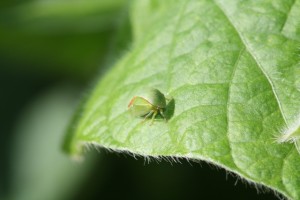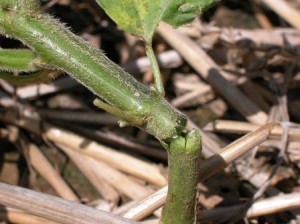
Recent research in the Mid-South has convinced me that threecornered alfalfa hopper (TCAH) is almost exclusively a pest of only small soybeans. We’ve had a relatively mild winter. Tennessee is on the northern edge of threecornered alfalfa hopper home range, and warm winters generally means higher populations. That appears to be the case in 2016. Late planted soybean such as those planted behind wheat are often the worst infested fields. Fields should be scouted from emergence until plants are about 10-inches tall. Adults infesting fields will girdle the main stems of seedling plants with their beak. Girdled planted will sometimes break as you walk through the field, but often, the lodging doesn’t occur until much later in the season after a thunderstorm. Here are a few points to consider when managing TCAH in soybean.
- Lodging and potential yield loss is much more likely to occur where plant populations are low. The beans get bushier and more top heavy, and they don’t have neighbors to help support their own weight. Field edges may be most affected.
- Insecticides seed treatments help but are not foolproof. Injury often occurs on field edges, and Insecticide seed treatments may not work well in small fields because adults migrate into fields and cause the injury before succumbing to the insecticide.
- Foliar insecticides such as Orthene/Acephate and the pyrethroids generally provide good control, but applications need to be made before significant girdling has already occurred.

Scouting for threecornered alfalfa hoppers is tricky. One suggestion is to bend seedling soybeans over with a yardstick and sweep-net handle and see how may stems ‘pop over’. Treatment can be considered if 10% or more of the plants snap when bent over. The “book” says treat when 10% or more of seedling plants are infested, but it is difficult to get an accurate count. I suggest walking fields and looking for these hopping little green bugs. If they a pinging around all over the place, there a good chance treatment is needed. Gently sweeping even very small beans can give you some idea if they are common or not. I’d get nervous if catching 20-30 TCAH per 100 sweeps on plants that are not even at V2-V3, but seeing just a few is no cause for alarm.

